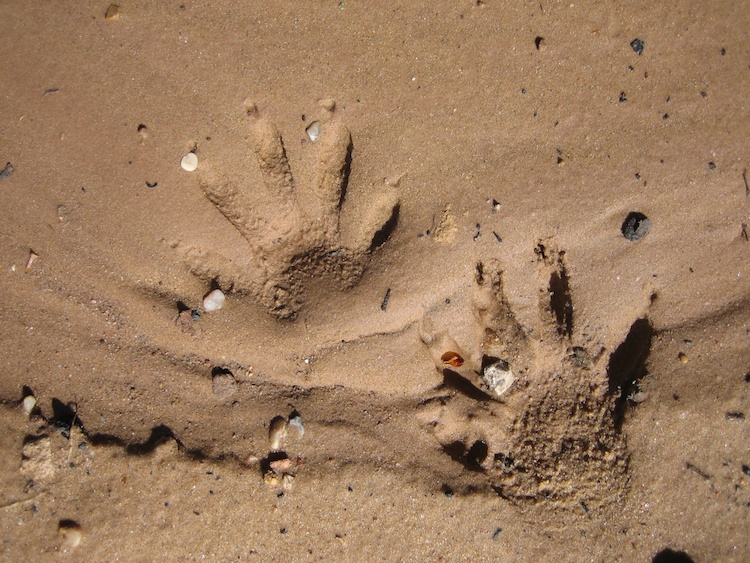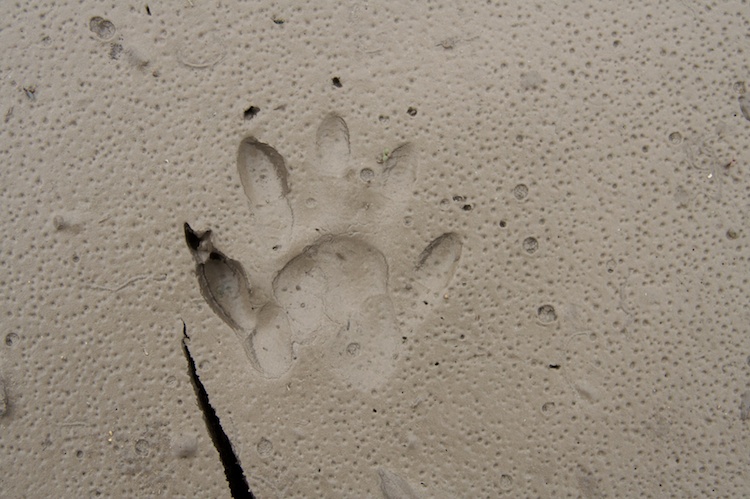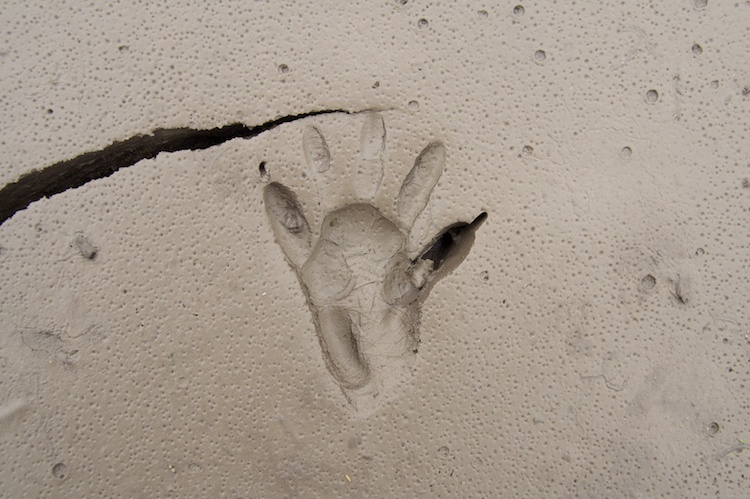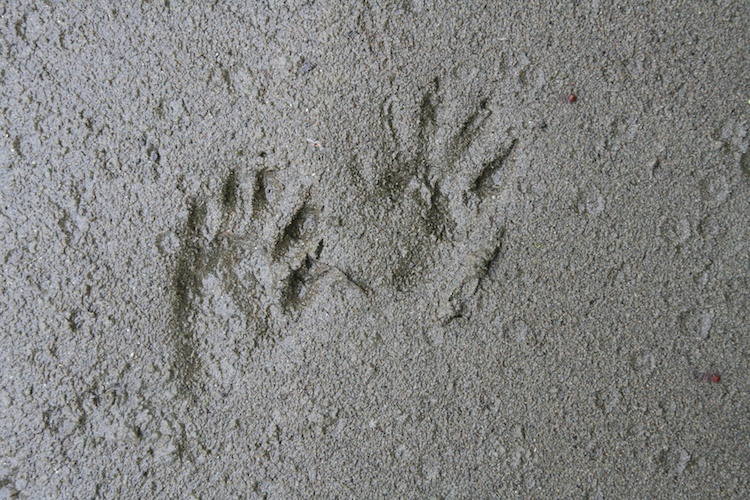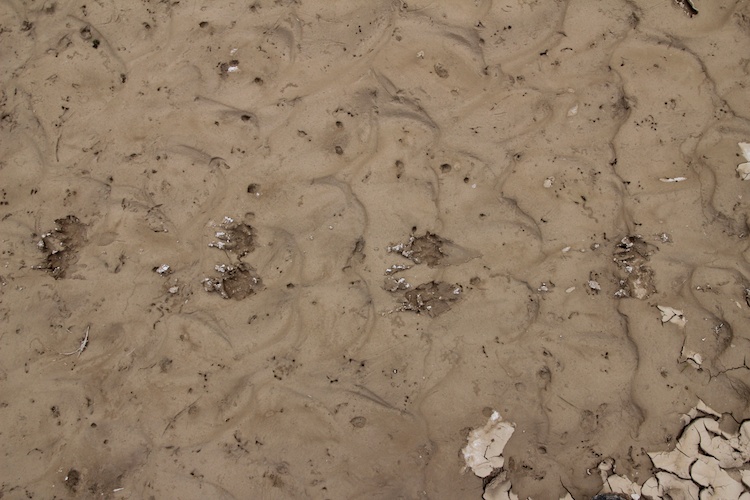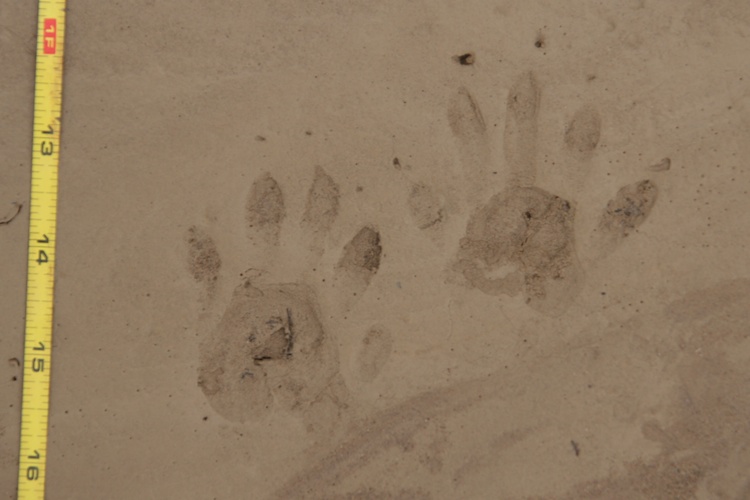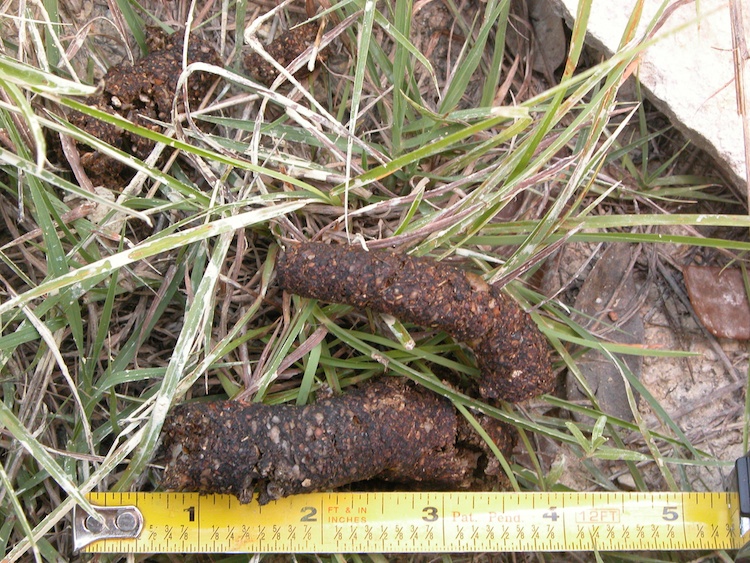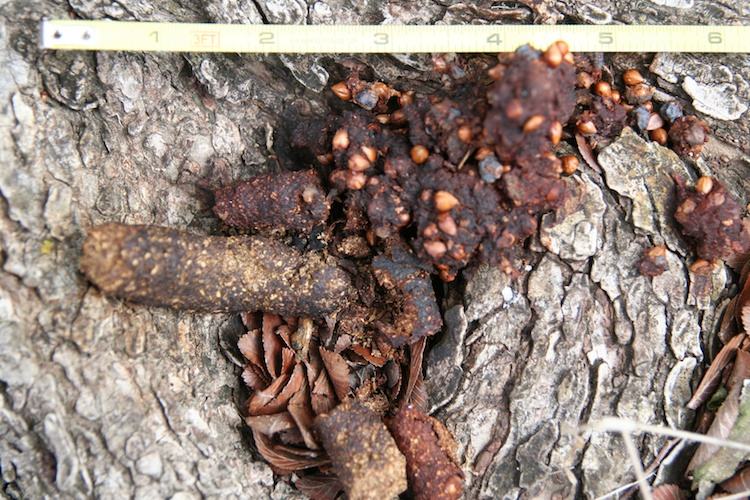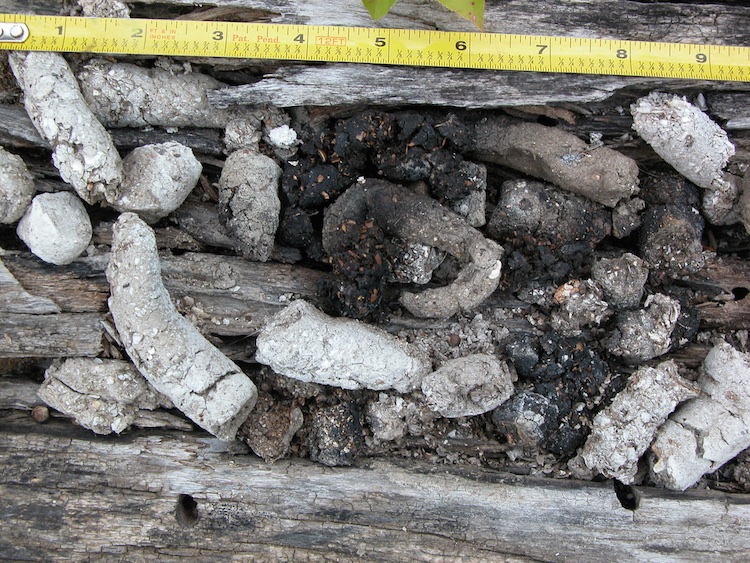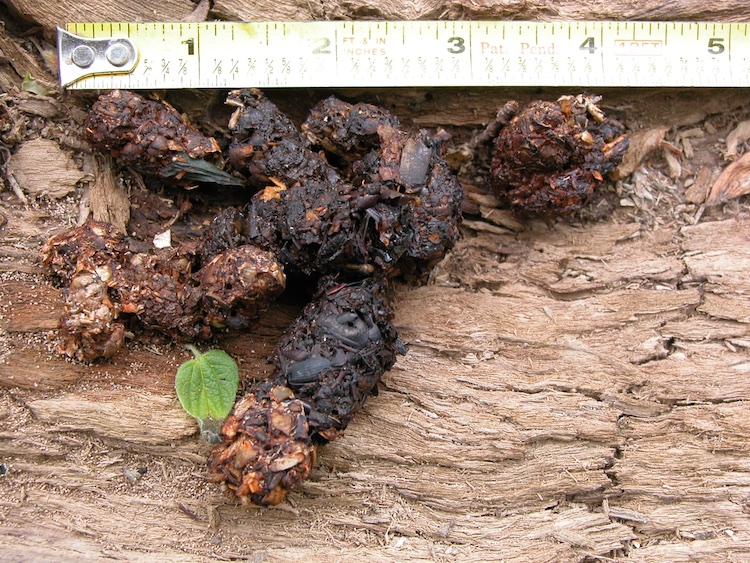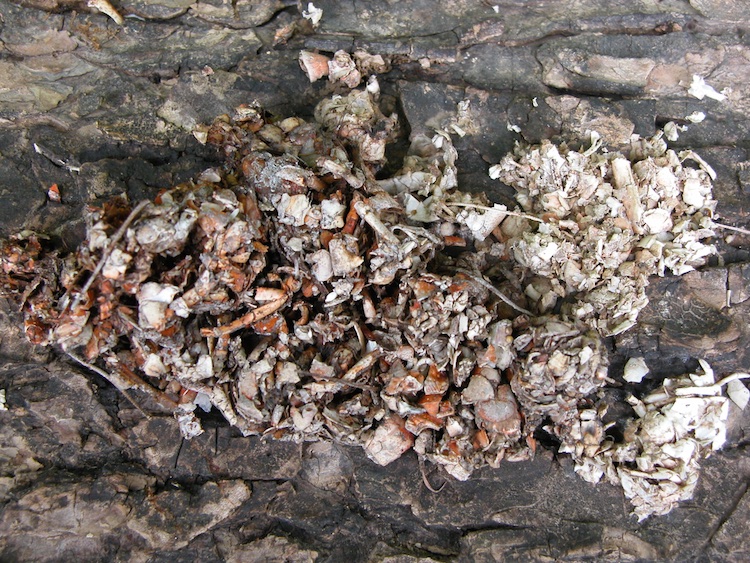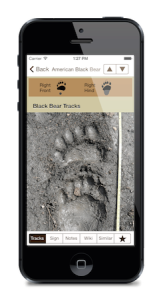Raccoon Right Front Track
- 1.5 – 3.2 in (3.8 – 8 cm) long.
- 1.4 – 2.9 in (3.6 – 7.3 cm) wide.
- 5 long toes. Toes tend to be slightly splayed. The inside toe (toe 1) registers slightly lower than the rest. The toes tend to connect to the palm pad.
- Small, sharp claws.
- The track is slightly asymmetrical.
- Palm pad is “C” shaped and is slightly wider on the outside. Negative space at the posterior end of the palm pad forms a small mound in the middle of the track.
- There is a heel pad on the outside of the leg that may register behind the palm pad.
- Smaller than the hind track.
![]()
Raccoon Right Hind Track
- 1.4 – 4.1 in (3.7 – 10.2 cm) long.
- 1.3 – 3 in (3.5 – 7.5 cm) wide.
- 5 long toes. The inside toe (toe 1) registers slightly lower than the rest. Toes tend to point forward more than those of the front track. Toes tend to connect to the palm pad.
- Small, sharp claws.
- The track is asymmetrical.
- Palm pad is large and curved and gets larger to the outside. Much less negative space at the posterior end of the pad than found in the front track.
- A long heel pad may register.
- Larger than the front track.
![]()
Photos of Raccoon Tracks
Raccoons show 5 long toes in the front and hind tracks. The track on the left is the left front and the track on the right is the right hind.
The toes of the front track tend to splay wider than the hind. The palm pad of the hind track is usually larger. The track on the left is the left front and the track on the right is the right hind.
Note the crescent-shaped palm pad in this perfect right front track of a raccoon. The pad is wider on the outside portion of the foot.
Raccoons have an unusual way of walking where each hind foot lands next to the opposite front foot. This creates an easy to recognize 2x pattern that can be helpful for identification.
Raccoon tracks in a slow walking pattern. Note that rather than the hind track landing next to the opposite front track, it instead landed slightly before.
Raccoon Scat (Feces)
The following images are the recent raccoon track and sign observations from the North American Animal Tracks Database. This is an iNaturalist project where trackers share observations and help each other learn about animal tracks, all while contributing to scientific research. Identifications of tracks on this page are initially made by members of the public and may not be correct. The tracks will eventually be verified by experts.
Raccoon Scat
Shape:
Tubular and smooth with generally blunt ends.
Consistency:
Often contains insects, seeds, grains, crayfish, etc. Occasionally, scats will contain 100% crayfish and may look similar to otter scat. Raccoons chew and digest more thoroughly than otters, and crayfish parts are smaller than in otter scats.
Smell:
Grainy.
Location:
Latrines are often found at the bases of large trees near water on the inland side of the tree. Also found on logs, rocks, and other raised objects
Notes:
While extremely rare, smelling raccoon can potentially be fatal due to a parasite known as Baylisascaris procyonis.
River Otter Scat
Shape:
Irregular shaped cords with tapered or blunt ends; sometimes amorphous blobs.
Consistency:
In the summer, fish is in 14% of scats and crayfish is in 98%. In the winter, many more scats contain fish and the scales will be apparent. Compared to raccoon, otter scat generally has larger pieces of crayfish, such as entire legs and antennae.
Smell:
Musky or like a dead animal
Location:
Raised areas near water, especially the shortest distance between two water bodies or on peninsulas. Usually on the ground, but occasionally on logs, also at the intersection of two creeks.
Notes:
Otter scats are also called “spraints.”
See my article: Aging Animal Scats: A River Otter Scat Study for more photos of river otter scat.
There are many great guides to identifying animal tracks. While a few are truly excellent, there are others with surprising inaccuracies. The guides below are my absolute favorites and won’t lead you astray. If you decide to purchase any of these guides, using the links below will help support future developments to this website.
iTrack Wildlife is my own guide to animal tracks for the iPhone and Android. It has over 700 high resolution photos of tracks, scats, sign, and skulls. It also has over 120 accurate track drawings for 66 mammals. What makes this app really different from other guides to animal tracks is the search tools that let you quickly narrow down a track by size, the number of toes, the shape of the toes, track symmetry, the mammal group, and the state or province.
Mammal Tracks and Sign of North America by Mark Elbroch is the modern bible of animal track and sign identification. Its publication drastically changed the field of animal tracking and spawned a renewal of interest in the field. It has hundreds of color photos and precise track drawings. The book is organized by the type of sign (tracks, scats, chews, digs, etc) making it easy to identify sign, but not great if you want to read about all the details of a single species. Also, the comprehensive nature of this book makes it an amazing resource, but it can be quite a load in your backpack. If you don’t own this book and you’re serious about tracking, you should definitely get it.
Animal Tracks and Scat of California is a regional guide, but many of the species are found throughout North America. This guide includes mammals, birds, and even some reptiles, amphibians, and invertebrates. It is a great general tracking guide (full disclaimer: I am a co-author of this guide) and is a great bet if you want a single guide that covers more than just mammals. This book also has some helpful sections not found in Bird Tracks and Sign including a quick reference to life-sized bird tracks.
Wildlife of the Pacific Northwest is a regional guide written by my friend and excellent tracker David Moskowitz. While the book primarily focuses on the Northwest, much of the information applies nationwide. This tracking guide includes mammals, birds, reptiles, amphibians, and invertebrates. The guide also contains excellent original artwork and beautiful photography. This guide is truly worth adding to your library.
The Peterson Guide to Animal Tracks is the classic tracking guide. This book was published in 1954 and inspired many trackers and naturalists. It was a major work for an author at the time with so few other resources available and predictably it contained several small errors. In 2005 is was updated by Mark Elbroch who made corrections, added information, and many photos.
Tracking and the Art of Seeing by Paul Rezendes was the first animal tracks guide in North America to contain color photographs. This guide drastically changed the landscape of future tracking guides. For example, just about every single subsequent field guide uses a similar stipple-point style for drawing tracks. This guide is more of a desk reference and is great reading. It is organized by species, so it is great for learning about an animal, but difficult to use to identify a particular type of sign.
A Field Guide to Mammal Tracking in North America by Jim Halfpenny is a classic guide that led to many advances in animal tracking. While the guide doesn’t contain color photos of tracks, there is a valuable scientific approach to identifying tracks that has very practical applications. He also covered gaits and animal movements in the most comprehensive manner at the time. While there are newer guides with perhaps more accurate information available, this guide made them possible.
The Animal Tracks: Midwest Edition by Jonathan Poppele is a book that surprised me. I expected this guide to be just another low quality pocket guide. However, what I found was anything but low quality. It has fantastic track drawings, accurate information, and a very handy organization method. This book is inexpensive and worth adding to your library.
Looking for More?
Sign Up to Get News, Updates, and Tracking Tips by Email.





